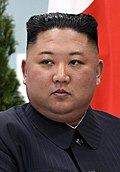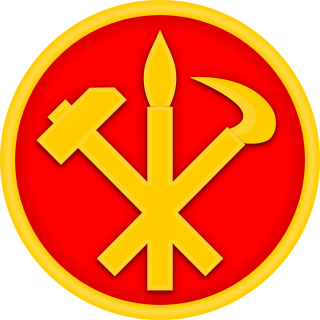Supreme Leader (North Korean title)
Political term for the top leader in North Korea From Wikipedia, the free encyclopedia
The supreme leader of North Korea (Korean: 최고령도자; MR: Ch'oego Ryŏngdoja) is the de facto hereditary leadership of the Workers' Party of Korea, the state and the Korean People's Army. The title is honorary, given only after death in the first two cases. More broadly it can also refer to the "Supreme Leader system" (Suryeong-je), which is defined as "a system that aims to ensure continuous leadership by the Supreme Leader across generations."[1] Different titles were used in North Korean propaganda that could be translated from Korean as "Great Leader", "Dear Leader", or "Supreme Leader".
| Supreme Leader of the Democratic People's Republic of Korea | |
|---|---|
State | |
 | |
| Incumbent | |
 | |
| Kim Jong Un since 17 December 2011 | |
| Details | |
| Style | |
| Heir presumptive | Kim Ju Ae Kim Yo Jong |
| First monarch | Kim Il Sung |
| Formation | 9 September 1948 |
| Residence | Ryongsong Residence |
| Appointer | 1 |
Overview
"Supreme Leader" was originally a designation used for Kim Il Sung only, and only after his death.[1] During his lifetime he was known as "Great Leader" (위대한 수령), a title to this day that only refers to him.[1] His son, Kim Jong Il, was known as "Dear Leader" (친애하는 령도자) during his lifetime, and only after death did North Korean media begin calling him "Supreme Leader", in the tradition of his father.[1] The grandson, Kim Jong Un, was first called "Supreme Leader" in a North Korean newspaper article dated October 3, 2020, with the frequency increasing since then, including sometimes "great Supreme Leader".[1] He was the first to be frequently called "Supreme Leader" while still alive, and at the relatively young age of 37.[1] The 2020 newspaper article was part of the official preparations to appoint Kim Jong Un as the General Secretary of the Workers' Party of Korea i.e. leader of the Workers' Party, the sole political body in the country and the paramount leader position.[1][2] Since November 2021, South Korean media have all reported that Kim Jong Un is called "Supreme Leader" (Suryeong) in North Korea.[1]
List
| No | Portrait | Name (Birth–Death) |
Title(s) | Period | Tenure (Time in office) |
Ideological contribution(s) |
|---|---|---|---|---|---|---|
| 1 |  |
Kim Il Sung 김일성 (1912–1994) |
Premier of the Cabinet of the DPRK | 9 September 1948[3] – 28 December 1972[4] | 9 September 1948[3] — 8 July 1994[5] (45 years, 302 days) |
Juche |
| Chairman of the WPK | 24 June 1949[6] – 12 October 1966[7] | |||||
| General Secretary of the WPK | 12 October 1966[7] – 8 July 1994[5] | |||||
| President of the DPRK | 28 December 1972[8] – 8 July 1994[5] | |||||
| 2 |  |
Kim Jong Il 김정일 (1941–2011) |
Chairman of the National Defence Commission of the DPRK | 9 April 1993[9] – 17 December 2011[10] | 8 July 1994[9] — 17 December 2011[10] (17 years, 162 days) |
Kimilsungism Songun Ten Principles |
| General Secretary of the WPK | 8 October 1997[9] – 17 December 2011[10] | |||||
| 3 |  |
Kim Jong Un 김정은 (born 1982 or 1983/1984) |
First Secretary of the WPK | 11 April 2012[11] – 9 May 2016[12] | 17 December 2011[13] — present (13 years, 136 days) |
Kimilsungism–Kimjongilism Byungjin |
| First Chairman of the National Defence Commission of the DPRK | 11 April 2012[14] – 29 June 2016[15] | |||||
| Chairman of the WPK | 9 May 2016[16] – 10 January 2021[17] | |||||
| President of the State Affairs Commission of the DPRK | 29 June 2016[15] – present | |||||
| General Secretary of the WPK | 10 January 2021[18] – present |
- Bold offices refer to the highest positions in the Workers' Party of Korea, the lone political party of North Korea.
Timeline

See also
References
External links
Wikiwand - on
Seamless Wikipedia browsing. On steroids.
